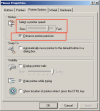Hello folks.
I have done a good amount of research and I'm still unable to determine how I can perform real emulation of a joystick.
What I found on the web was using the mouse movements to simulate a joystick that moves an imaginary little ball.
No, what I wish to do is to emulate a real joystick, programmatically.
The reason is that I'm working with a hardware device for disabled people, this device allows a disabled person to access the PC and I want the device together with my code to replace the joystick.
Basically, the disabled person uses this device in 'joystick' mode which will trigger/produce/generate the same output that a joystick outputs to Windows; to perform a real emulation of a standard joystick.
Thank you for your time!

